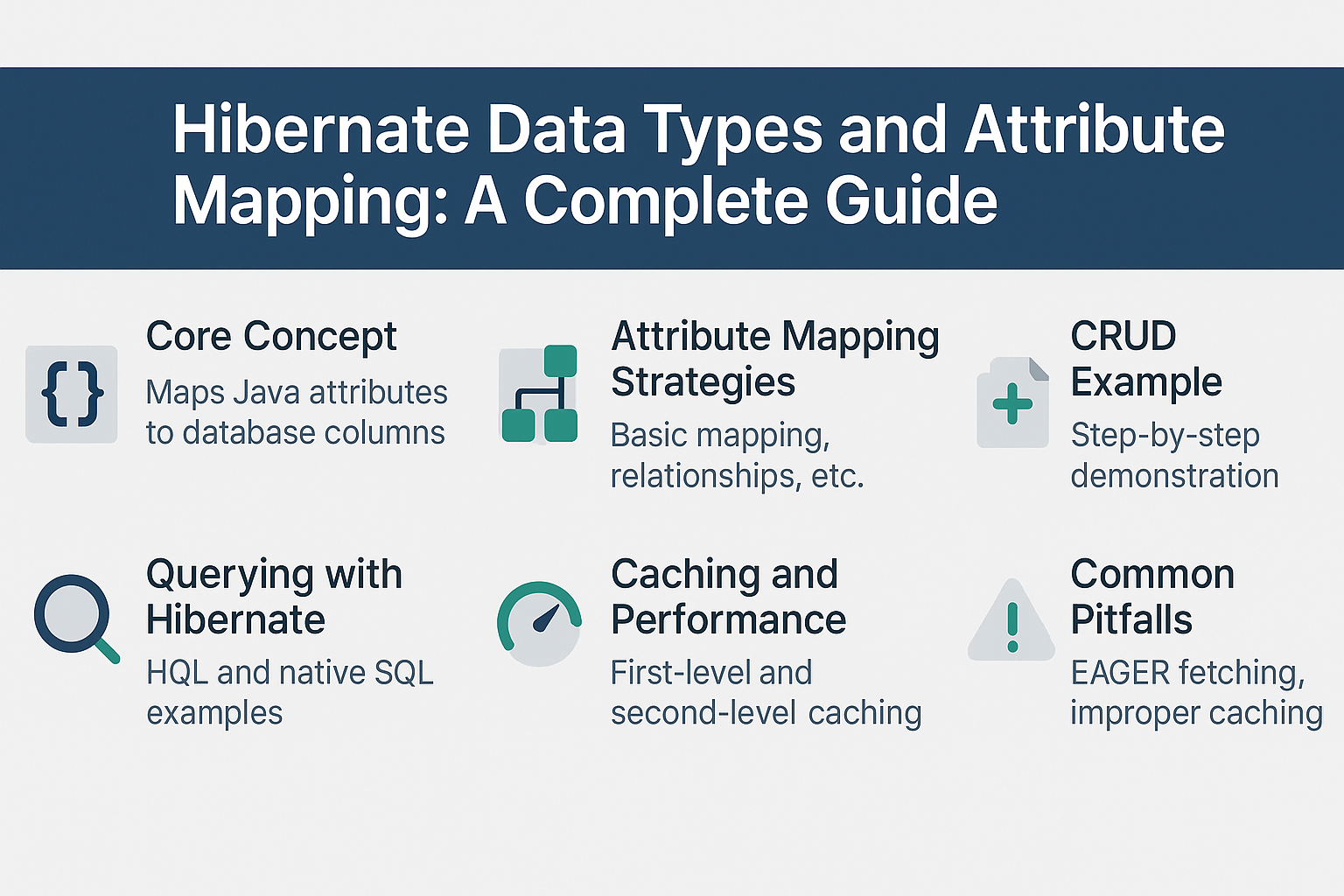Hibernate is one of the most popular ORM (Object-Relational Mapping) frameworks in Java. At its core, Hibernate bridges the gap between Java objects and relational database tables. One of the key concepts in this mapping process is data types and attribute mapping.
Correctly mapping Java attributes to database columns ensures:
- Data integrity
- Optimal performance
- Easier debugging and maintenance
- Seamless integration with other frameworks like Spring Boot
In this tutorial, we’ll dive deep into how Hibernate handles different data types, mapping strategies, best practices, and common pitfalls.
Core Concept: Hibernate Data Types
Hibernate provides two categories of data types:
- Java Types (Entity Attributes) – Java primitive types and objects.
- SQL Types (Database Columns) – SQL column definitions that Hibernate maps automatically.
Hibernate internally converts between these two via its Type System.
Commonly Used Data Types
| Java Type | Hibernate Mapping | SQL Column Type |
|---|---|---|
int, Integer |
@Column |
INTEGER |
long, Long |
@Column |
BIGINT |
double, Double |
@Column |
DOUBLE |
String |
@Column |
VARCHAR / TEXT |
boolean, Boolean |
@Column |
BOOLEAN |
Date |
@Temporal |
DATE / TIMESTAMP |
LocalDate |
@Column |
DATE |
LocalDateTime |
@Column |
TIMESTAMP |
BigDecimal |
@Column |
DECIMAL / NUMERIC |
byte[] |
@Lob |
BLOB |
char[] |
@Lob |
CLOB |
Attribute Mapping Strategies
Basic Mapping
@Entity
@Table(name = "users")
public class User {
@Id
@GeneratedValue(strategy = GenerationType.IDENTITY)
private Long id;
@Column(nullable = false, length = 100)
private String name;
@Column(unique = true, nullable = false)
private String email;
@Temporal(TemporalType.DATE)
private Date birthDate;
@Lob
private String profileDescription;
}
Relationships
- One-to-One
- One-to-Many / Many-to-One
- Many-to-Many
Example:
@Entity
public class Order {
@Id
@GeneratedValue(strategy = GenerationType.IDENTITY)
private Long id;
@ManyToOne(fetch = FetchType.LAZY)
private User user;
@OneToMany(mappedBy = "order", cascade = CascadeType.ALL)
private List<OrderItem> items;
}
Step-by-Step CRUD Example
Create
Session session = sessionFactory.openSession();
Transaction tx = session.beginTransaction();
User user = new User();
user.setName("Ashwani Kumar");
user.setEmail("ashwani@example.com");
session.persist(user);
tx.commit();
session.close();
Read
Session session = sessionFactory.openSession();
User user = session.get(User.class, 1L);
System.out.println(user.getName());
session.close();
Update
Session session = sessionFactory.openSession();
Transaction tx = session.beginTransaction();
User user = session.get(User.class, 1L);
user.setName("Updated Name");
session.update(user);
tx.commit();
session.close();
Delete
Session session = sessionFactory.openSession();
Transaction tx = session.beginTransaction();
User user = session.get(User.class, 1L);
session.delete(user);
tx.commit();
session.close();
Hibernate Session and Transactions
- Session: Represents a single unit of work with the database.
- SessionFactory: Heavy-weight object for creating sessions.
- Transaction: Ensures atomicity of operations.
Best practice: Always wrap database operations in a transaction.
Querying with Hibernate
HQL Example
List<User> users = session.createQuery("FROM User u WHERE u.email LIKE '%@gmail.com'", User.class).list();
Native SQL Example
List<Object[]> results = session.createNativeQuery("SELECT name, email FROM users").list();
Caching and Performance
- First-Level Cache: Default, Session-scoped.
- Second-Level Cache: Shared across sessions (e.g., EHCache, Infinispan).
- Query Cache: Stores query results.
Real-world analogy: First-level cache = personal notes, second-level cache = shared office whiteboard.
Real-World Integration: Spring Boot
Add dependency:
<dependency>
<groupId>org.springframework.boot</groupId>
<artifactId>spring-boot-starter-data-jpa</artifactId>
</dependency>
Configure application.properties:
spring.datasource.url=jdbc:mysql://localhost:3306/mydb
spring.datasource.username=root
spring.datasource.password=pass
spring.jpa.show-sql=true
spring.jpa.hibernate.ddl-auto=update
Common Pitfalls
- Misusing EAGER fetching → leads to N+1 queries.
- Improper cascading → accidental deletions.
- Not using indexes → poor performance.
Best Practices
- Use
LAZYloading by default. - Always define lengths for
Stringcolumns. - Prefer
LocalDate/LocalDateTimeoverDate. - Implement DTOs for read-heavy queries.
📌 Hibernate Version Notes
Hibernate 5.x
- Relies on javax.persistence namespace.
- Legacy
SessionFactoryconfiguration.
Hibernate 6.x
- Migrated to jakarta.persistence namespace.
- Improved SQL support with better type mappings.
- Enhanced query API with
CriteriaUpdate,CriteriaDelete.
Conclusion and Key Takeaways
- Hibernate maps Java objects to database tables seamlessly.
- Attribute mapping ensures correct data storage.
- Performance tuning (caching, fetch strategies) is essential.
- Hibernate 6 brings improved SQL handling and Jakarta compliance.
FAQ
Q1: What’s the difference between Hibernate and JPA?
A: JPA is a specification; Hibernate is an implementation with extra features.
Q2: How does Hibernate caching improve performance?
A: By storing frequently accessed data in memory, reducing DB trips.
Q3: What are the drawbacks of eager fetching?
A: It loads unnecessary data, causing performance issues.
Q4: How do I solve the N+1 select problem in Hibernate?
A: Use JOIN FETCH or batch fetching.
Q5: Can I use Hibernate without Spring?
A: Yes, Hibernate can work as a standalone ORM.
Q6: What’s the best strategy for inheritance mapping?
A: Depends on use case — SINGLE_TABLE for performance, JOINED for normalization.
Q7: How does Hibernate handle composite keys?
A: With @EmbeddedId or @IdClass.
Q8: How is Hibernate 6 different from Hibernate 5?
A: Hibernate 6 uses jakarta.persistence and has enhanced query APIs.
Q9: Is Hibernate suitable for microservices?
A: Yes, but lightweight ORMs or JDBC may be preferable for ultra-high performance.
Q10: When should I not use Hibernate?
A: For simple projects with minimal database interaction where plain JDBC is sufficient.
